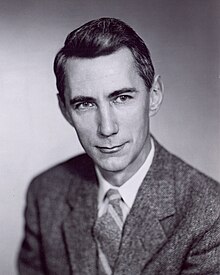Portal:Electronics/Selected biography/19
Claude Elwood Shannon (April 30, 1916 – February 24, 2001) was an American mathematician, electrical engineer, computer scientist and cryptographer known as the "father of information theory" and as the "father of the Information Age". Shannon was the first to describe the Boolean gates (electronic circuits) that are essential to all digital electronic circuits, and was one of the founding fathers of artificial intelligence. He is credited alongside George Boole for laying the foundations of the Information Age.
At the University of Michigan, Shannon dual degreed, graduating with a Bachelor of Science in both electrical engineering and mathematics in 1936. A 21-year-old master's degree student at the Massachusetts Institute of Technology (MIT) in electrical engineering, his thesis concerned switching circuit theory, demonstrating that electrical applications of Boolean algebra could construct any logical numerical relationship, thereby establishing the theory behind digital computing and digital circuits. The thesis has been claimed to be the most important master's thesis of all time, as in 1985, Howard Gardner described it as "possibly the most important, and also the most famous, master's thesis of the century", while Herman Goldstine described it as "surely ... one of the most important master's theses ever written ... It helped to change digital circuit design from an art to a science." It has also been called the "birth certificate of the digital revolution", and it won the 1939 Alfred Noble Prize. Shannon then graduated with a PhD in mathematics from MIT in 1940, with his thesis focused on genetics, with it deriving important results, but it went unpublished. (Full article...)

